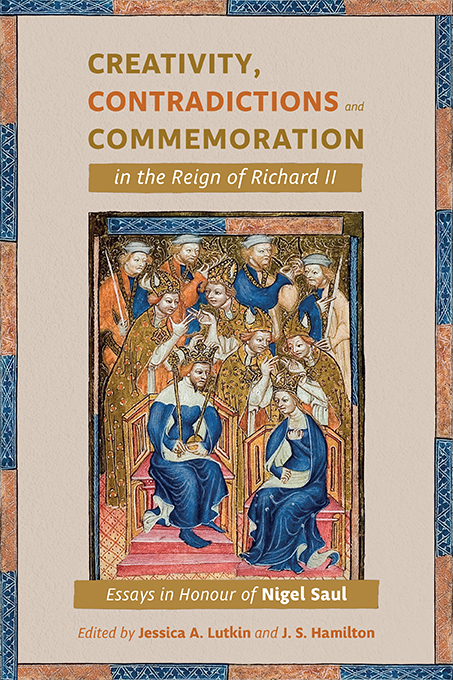 Creativity, Contradictions and Commemoration in the Reign of Richard II
Creativity, Contradictions and Commemoration in the Reign of Richard II 12 - ‘Suche scripture … shewyng what I was’: The Brass of Margaret of Cieszyn and Associated Monuments
Published online by Cambridge University Press: 26 May 2022
Summary
The church of St Margaret, Felbrigg, near Cromer on the Norfolk coast, sits at the end of a lane in the middle of parkland facing on to Felbrigg Hall, a Jacobean country house now in the care of the National Trust. Lift up the carpets that cover the narrow aisle between the Georgian pews and you will discover the c. 1417 brass monument commemorating Sir Simon Felbrigg, son of Sir Roger Felbrigg and Elizabeth Scales, and his first wife, Margaret (Małgorzata), daughter of Przemysław I, duke of Cieszyn, a region near the present-day Polish–Czech border that by the fourteenth century was a fiefdom of the Kingdom of Bohemia. Simon and Margaret each held senior positions at the court of Richard II – he was by 1395 the royal standard bearer and knight of the king's chamber, and she had been the most senior lady to accompany Richard's first wife, Anne of Bohemia, to England from her childhood home near Prague. When the brass that he commissioned shortly after her death in 1416 is mentioned by scholars, it is generally to comment upon the multitude of symbols that recall the couple's royal connections. Of five surviving heraldic shields that surmount the brass, the two most prominent show the heraldic arms favoured by Richard II (which impale the arms attributed to Edward the Confessor with those of England quartering France) and those of Anne of Bohemia (per pale of three, with the third showing the quartered arms of Bohemia with the imperial eagle, in recognition of Anne's father's status as Holy Roman Emperor). Simon is depicted wearing the garter that confirms him as one of England's most elite knights and is also resting a diminutive royal standard in the crook of his arm; a miniscule hart (Richard's personal badge) reclines at the base of the central canopy. The inscription avoids the chance that any detail might be overlooked, explicitly stating that Simon was ‘standard bearer to the most illustrious lord, King Richard II’ and that Margaret was ‘companion to the most noble lady, Lady Anne, sometime Queen of England’.
Beneath the side-by-side arms of king and queen on the tomb are the impaled arms of Simon and Margaret, and underneath those the two individuals appear within a canopied frame: two pieces of brass set into one stone.
- Type
- Chapter
- Information
- Creativity, Contradictions and Commemoration in the Reign of Richard IIEssays in Honour of Nigel Saul, pp. 235 - 248Publisher: Boydell & BrewerPrint publication year: 2022


